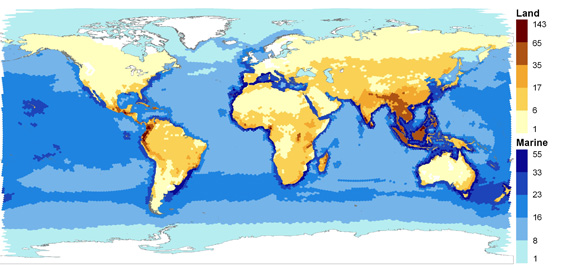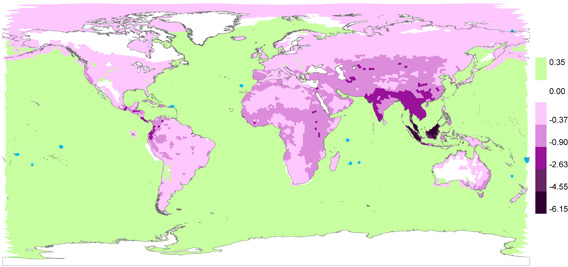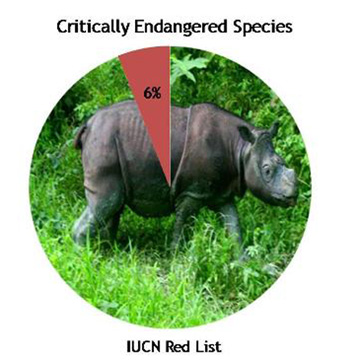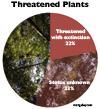A fifth of the world’s vertebrate species (i.e. mammals, birds, reptiles, amphibians, and fish) are threatened with extinction, according to a massive new study by the International Union for the Conservation of Nature (IUCN); and the situation is worsening for the world’s wildlife: on average 52 species of mammals, birds, and amphibians move one category closer to extinction every year (the IUCN Red List categorizes species as Least Concern, Near Threatened, Vulnerable, Endangered, Critically Endangered, Extinct in the Wild, and then Extinct). However, the news isn’t all bad. The study found that conservation action does work: in the first analysis of its kind, researchers found that the global biodiversity decline would have been 18% worse if not for conservation attention, “nonetheless,” the authors—174 scientists from 38 countries—write, “current conservation efforts remain insufficient to offset the main drivers of biodiversity loss.” According to the study, these drivers include agricultural expansion, logging, over-exploitation of species, and invasive species.
“The ‘backbone’ of biodiversity is being eroded,” said renowned ecologist and writer Professor Edward O. Wilson from Harvard University. “One small step up the Red List is one giant leap forward towards extinction. This is just a small window on the global losses currently taking place.”
The study is being launched today at the Convention on Biological Diversity (CBD) in Nagoya, Japan. International leaders are meeting to come up with an agreement to save biodiversity after failing to meet the goal of stemming biodiversity loss by this year.
The Hardest Hit
According to the study, the worst place to be an animal in the world is the tropics, with particular emphasis on the Southeast Asian tropics. Southeast Asia sports the world’s highest concentration of threatened species. Deforestation has exploded in many countries in Southeast Asia over the past few decades from unsustainable logging and industrial plantations, such as palm oil, rice, and pulp and paper. In addition, hunting for food and traditional medicines has decimated a large number of animals in the region.

Global patterns of threat, for land (terrestrial and freshwater, in brown) and marine (in blue) vertebrates, based on the number of globally threatened species in total. Darker areas have higher concentrations of threatened species. Click to enlarge.
Even Southeast Asia’s most iconic species—rhinos, orangutans, tigers, and elephants—face extirpation and in some cases total extinction. The Javan rhinoceros is down to some 40-60 individuals, none of which are in captivity.
But as far as type of species goes, nothing is worse than being a frog: according to the study 41% of the world’s amphibians are threatened with extinction. In contrast, 33% of cartilaginous fishes, 25% of mammals, 22% of reptiles, 15% of bony fishes, and 13% of birds are threatened.
Highly-sensitive to environmental changes amphibians face a barrage of threats, including habitat loss, pollution, climate change, agricultural chemicals, and overconsumption for food and the pet trade. However, the largest threat to amphibians is known as the ‘amphibian plague’: chytridiomycosis, a fungal disease, has decimated amphibian populations even in pristine environments. Recent studies have shown that frog species never known to science have already been lost. At least 120 amphibians have vanished entirely in the past three decades, making this group a poster child for the extinction crisis.
But of all the world’s species—vertebrates, plants, fungi, insects, etc.—vertebrates make up just 3% of the total. The study also reported on a number of non-vertebrate species types—not included in the overall analysis—finding, for example, that 14% of seagrasses, 32% of freshwater crayfish, and 33% of coral reef species are threatened with extinction. An earlier study, looking at a representative sample of plants, found that 22% of the world’s plant species are threatened with extinction.
One of the most threatened groups of species on Earth is the cycads, an ancient group of plants: 63% percent of cycads face extinction.
Conservation Works
On the bright side, the study also found that conservation action—such as protected areas and legislation—has mitigated some of the loses in species and abundance. Analyzing species that have seen improvement from conservation attention, the study found that the biodiversity crisis would be 18 percent worse today for birds and mammals if conservation action hadn’t occurred.

Global patterns of net change in overall extinction risk across birds, mammals and amphibians mapped as average number of genuine Red List category changes per cell per year. Purple shades correspond to net deterioration (i.e., net increase in extinction risk) in that cell, green to net improvement (i.e., decrease in extinction risk), and white to no change. The uniform pattern of improvement at sea is driven by improvements of migratory marine mammals with cosmopolitan distributions (e.g., humpback whale). Click to enlarge.
“History has shown us that conservation can achieve the impossible, as anyone who knows the story of the White Rhinoceros in southern Africa knows”, remarked Dr Simon Stuart, Chair of IUCN’s Species Survival Commission and an author on the study. “But this is the first time we can demonstrate the aggregated positive impact of these successes on the state of the environment.”
In 7% of cases species that moved categories in the assessment moved to a safer category rather than a worst. While this is sad reflection of the state of biodiversity worldwide, the researchers found that nearly all of those species that showed improvement did so because of targeted conservation action. However, according to the authors, even this assessment doesn’t measure the fill importance of conservation.
“These results grossly underestimate the impact of conservation, because they do not account for species that either would have deteriorated further in the absence of conservation actions, or improved numerically though not enough to change [their category],” the authors write.
In terms of effectiveness, the study found that conservationists were most adept at combating invasive species, rather than slowing deforestation or regulating hunting.
Three extreme cases of conservation-in-action included reintroducing animals back into their ecosystems after they have gone extinct in the wild: the California Condor, (Gymnogyps californianus), the Black-footed Ferret, (Mustela nigripes), and Przewalski’s Horse (Equus ferus). Such species give hope in particular to amphibians, some of whom survive now only in zoos. Currently one such frog, the Kihansi spray toad, is being reintroduced after going extinct in Tanzania.
“The stark reality of accelerating species losses can lead to a feeling of hopelessness,” says Mindell, Dean of Science at the California Academy of Sciences. “However, the IUCN data analyzed in this assessment show that concerted efforts by biologists and conservationists can make a positive difference in slowing rates of endangerment. Hopefully, these findings will bolster existing efforts at conservation—and spawn new initiatives as well.”
Yet, despite decades of conservation attention and funding, many notable species are still dropping in population: for example, according to the IUCN the tiger (panthera tigris) is still classified as Endangered and its population still decreasing. Although its likely tigers would be far worse off, maybe even extinct, if not for ongoing conservation measures.
In addition, most species in the world are not like tigers. They do not receive targeted conservation funds or attention, even when they are on the edge of extinction. For example, the Vietnam leaf-nosed bat (Paracoelops megalotis) was listed as Critically Endangered for 12 years before it was moved to Data Deficient. It remains wholly unstudied by researchers and may already be extinct. But no one knows.
“The current level of [conservation] action is outweighed by the magnitude of threat, and conservation responses will need to be substantially scaled up to combat the extinction crisis,” the authors conclude. “Even with recoveries, many species remain conservation-dependent, requiring sustained, long-term investment […] The 2010 [CBD] biodiversity target may not have been met, but conservation efforts have not been a failure. The challenge is to remedy the current shortfall in conservation action to halt attrition of global biodiversity.”
Total species assessed by the IUCN Red List = 55,926 (Scientists have identified almost 2 million species on Earth, though researchers estimate that there are probably 10-50 million species in total.)
 |
- Extinct = 791
- Extinct in the Wild = 63
- Critically Endangered = 3,565
- Endangered = 5,256
- Vulnerable = 9,530
- Near Threatened = 4,014
- Total Lower Risk/conservation dependent = 269 [this is an old category that is gradually being phased out of the Red List]
- Data Deficient = 8,358
- Least Concern = 24,080
Related articles
Losing nature’s medicine cabinet

(10/04/2010) In all the discussions of saving the world’s biodiversity from extinction, one point is often and surprisingly forgotten: the importance of the world’s species in providing humankind with a multitude of life-saving medicines so far, as well as the certainty that more vital medications are out there if only we save the unheralded animals and plants that contain cures unknown. Already, species have provided humankind everything from quinine to aspirin, from morphine to numerous cancer and HIV-fighting drugs. “As the ethnobotanist Dr. Mark Plotkin commented, the history of medicine can be written in terms of its reliance on and utilization of natural products,” physician Christopher Herndon told mongabay.com. Herndon is co-author of a recent paper in the journal Biotropica, which calls for policy-makers and the public to recognize how biodiversity underpins not only ecosystems, but medicine.
If Madagascar’s biodiversity is to be saved, international community must step up

(07/27/2010) The international community’s boycott of environmental aid to Madagascar is imperiling the island’s unique and endangered wildlife, according to a new report commissioned by the US Agency for International Development’s (USAID) Bureau of Africa. International aid to the desperately poor nation slowed to a trickle after a government coup last year, including a halt on environmental funding from the US government. Since then the island has experienced an environmental crisis: illegal loggers and traders began decimating protected areas, and the wildlife trade, including hunting endangered lemurs for bushmeat, took off.
Mass extinction fears widen: 22 percent of world’s plants endangered

(09/28/2010) Scientific warnings that the world is in the midst of a mass extinction were bolstered today by the release of a new study that shows just over a fifth of the world’s known plants are threatened with extinction—levels comparable to the Earth’s mammals and greater than birds. Conducted by the Royal Botanic Gardens, Kew; the Natural History Museum, London; and the International Union for the Conservation of Nature (IUCN), the study is the first time researchers have outlined the full threat level to the world’s plant species. In order to estimate overall threat levels, researchers created a Sampled Red List Index for Plants, analyzing 7,000 representative species, including both common and rare plants.
21% of Africa’s freshwater plants and animals threatened
(09/02/2010) 21 percent of African freshwater plant and animal species are threatened with extinction, according to a five year assessment of 5,167 freshwater species by 200 scientists.
Collapsing biodiversity is a ‘wake-up call for humanity’
(05/10/2010) A joint report released today by the Convention on Biological Diversity (CBD) and the UN Environment Program (UNEP) finds that our natural support systems are on the verge of collapsing unless radical changes are made to preserve the world’s biodiversity. Executive Secretary of the Convention on Biological Diversity, Ahmed Djoghlaf, called the bleak report “a wake-up call for humanity.”
Saving biodiversity ‘on the same scale’ as climate change: German Chancellor
(01/11/2010) In a kick-off event for the UN’s Year of Biodiversity, German Chancellor Angela Merkel, compared the importance of saving biodiversity to stopping climate change.
Reptiles underrepresented on the IUCN Red List

(11/04/2009) Currently there are an estimated nearly 9,000 reptiles in the world, while the International Union for Conservation of Nature (IUCN) Red List has assessed all of the world’s described mammals, birds, and amphibians, reptiles have yet to be fully assessed, leaving herpetologists with an unclear picture of how reptiles are faring in the world. Currently, 1,677 reptiles have been assessed (less than 20 percent of the total number of reptile species known) with 293 added this year.
Governments, public failing to save world’s species
(11/04/2009) According to the International Union for the Conservation of Nature’s (IUCN) 2008 report, released yesterday, 36 percent of the total species evaluated by the organization are threatened with extinction. If one adds the species classified as Near Threatened, the percentage jumps to 44 percent—nearly half.
Freshwater species worse off than land or marine
(10/15/2009) Scientists have announced that freshwater species are likely the most threatened on earth. Extinction rates for freshwater inhabitants are currently four to six times the rates for terrestrial and marine species. Yet, these figures have not lead to action on the ground.
Alleviating poverty and saving biodiversity are inherently linked argue scientists

(09/17/2009) Twenty-nine scientists argue in Science today that the world will not be able to lift up the world’s poor unless it also addresses global biodiversity loss. They say that the same underlying problems—exploitation of resources, unsustainable overconsumption, climate change, population growth—are exacerbating global poverty and the extinction of species.
Amphibians face mass extinction
(08/11/2008) Amphibians are in big trouble. At least one third of the world’s 6,300 known species are threatened with extinction, while at least 200 species have gone extinct over the past 20 years. Worryingly the outbreak of a deadly fungal disease, chytridiomycosis, is spreading throughout the tropics leaving millions of victims. A new study, published in the early edition of the Proceedings of the National Academy of Sciences, warns that there is “little time to stave off a potential mass extinction” of frogs, salamanders, and caecilians.
7 steps to solve the global biodiversity crisis
(08/11/2008) Many biologists believe Earth is entering a sixth mass extinction event, one that has is the direct of human activities, including over-exploitation, habitat destruction and introduction of alien species and pathogens. Climate change — largely driven by anthropogenic forces — is expected to soon increase pressure on Earth’s biodiversity. With population and per-capita consumption expected to grow significantly by the mid 21st century, there seems little hope that species loss can be slowed. Nevertheless, writing in the journal PNAS, Stanford biologists Paul R. Ehrlich and Robert M. Pringle suggest seven steps to help improve the outlook for the multitude of species that share our planet.
20% of the Brazilian Amazon’s tree species to go extinct
(08/11/2008) A new study estimates the number of trees that will go extinct in the Brazilian Amazon due to habitat loss.
Biodiversity extinction crisis looms says renowned biologist

(03/12/2007) While there is considerable debate over the scale at which biodiversity extinction is occurring, there is little doubt we are presently in an age where species loss is well above the established biological norm. Extinction has certainly occurred in the past, and in fact, it is the fate of all species, but today the rate appears to be at least 100 times the background rate of one species per million per year and may be headed towards a magnitude thousands of times greater. Few people know more about extinction than Dr. Peter Raven, director of the Missouri Botanical Garden. He is the author of hundreds of scientific papers and books, and has an encyclopedic list of achievements and accolades from a lifetime of biological research. These make him one of the world’s preeminent biodiversity experts. He is also extremely worried about the present biodiversity crisis, one that has been termed the sixth great extinction.